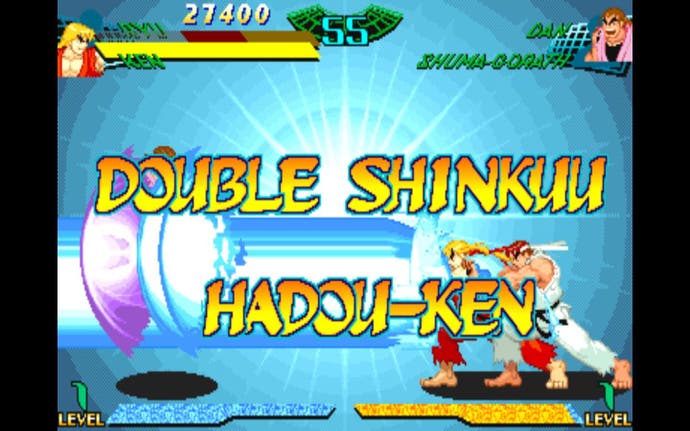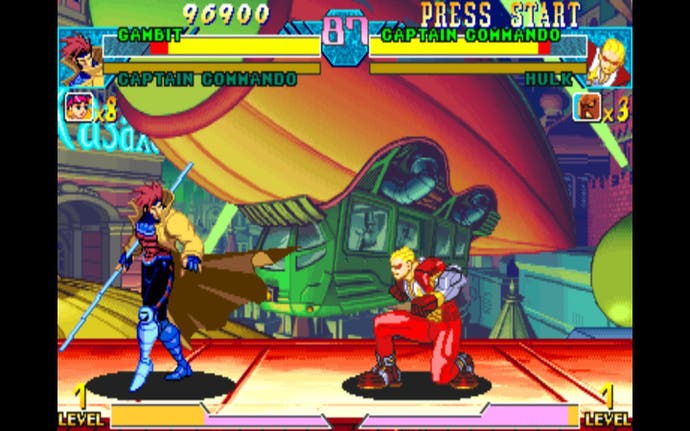Retrospective: Street Fighter
20 years of beat-'em-ups picked thoroughly apart.
Marvel vs. Capcom
Series:
(1996) X-Men vs. Street Fighter, (1997) Marvel Super Heroes vs. Street Fighter, (1998) Marvel vs. Capcom - Clash of Super Heroes, (2000) Marvel vs. Street Fighter 2 - New Age of Heroes
MvC Mechanics:
- Tag Team - never feel lonely again
- Super Jump - jump ridiculously high
- Aerial Rave - epic Air Combos
- Advancing Counter - pushes your opponent away whilst blocking
- Variable Attack - tag partner in and out
- Variable Combo - both characters Super simultaneously, takes two Super levels
- Variable Counter - similar to Alpha Counters, but tags partner in
- Variable Assist (MSHvSF) - your partner takes a cheap shot
- Variable Cross (MvC) - control both characters with unlimited Super
- Delayed Hyper Combo (MvC2) - characters take it in turns to use their Super
- Snapback (MvC2) - don't like who you're fighting? Force your opponent to tag out
In 1992 Konami released a scrolling beat-'em-up arcade game using Marvel's X-Men licence. The game was pretty decent for the time and is best remembered from its six-player deluxe cabinet. Marvel then allowed Capcom to produce another X-Men arcade game, which in 1994 became X-Men: Children of the Atom. Akuma was included as a secret boss. This was a competitive fighter that played in a similar style to the Darkstalkers games, and was successful enough to warrant a sequel the next year with Marvel Super Heroes. With Street Fighter Alpha 2 already out and the inherently similar styles of Alpha and the Marvel fighting game, the obvious thing to do was make a crossover fighter. Capcom hasn't looked back since.
X-Men vs. Street Fighter was a fanboy's dream. It was finally time to see whether Wolverine's adamantine skeleton would hold up to the onslaught of Akuma's Raging Demon. Hearing the announcer hysterically shout "this is X-Men vs. Street Fighter!" at the title screen is something I'll never forget. Indeed, the biggest surprise with X-Men vs. Street Fighter was the dual-character selection and tag-team gameplay. Rather than a best-of-three-rounds system, players instead chose two fighters with the match won once both opponents had been defeated. You could team up M. Bison with Magneto, not just for dual scheming, but striking colour coordination.

The pace of X-Men vs. Street Fighter was very rapid compared to Alpha, and players could switch between their two characters by quickly pressing both heavy buttons - the tagged-out character would also gradually recover some of their lost health. Each character also had a launcher move which would catapult their opponent high into the air, and if followed up with a well-timed Super Jump, could be the start of an awesome and highly damaging Air Combo. These would later become the series' signature Aerial Raves.
X-Men vs. Street Fighter just wasn't happy unless you were throwing out a Super every five seconds, with a three-tiered Super gauge that maxed at an alarming rate. Even more OTT were the Variable Combos. This was essentially a dual Super move where both fighters would execute their Supers simultaneously - often for over 50 consecutive hits. Useful considering the end boss was Marvel's gigantic Apocalypse.
A sequel followed with Marvel Super Heroes vs. Street Fighter, which traded a lot of the X-Men cast for broader Marvel offerings like Spider-Man and the Hulk - Wolverine and Cyclops were the only returning X-Men. Marvel Super Heroes vs. Street Fighter removed a lot of the abuse-able infinities in the previous game, but played and looked almost identical to the X-Men outing. One significant gameplay addition was the Variable Assist, which would call your partner in for a quick attack and was useful in extending combos.
Marvel Super Heroes vs. Street Fighter also gave specific names for certain dual Supers and included a Cyber-Akuma for players to take down after they'd toppled Apocalypse, although anyone who's ever played Cyberbots will know this wasn't the first time he'd been mechanised - that Gouki gets everywhere.
A year after Marvel Super Heroes vs. Street Fighter we got Marvel vs. Capcom, and, as the name suggests, Capcom looked beyond its Street Fighter catalogue and brought us the likes of Strider Hiryu and Captain Commando. Marvel vs. Capcom's first major change was the implementation of a striker system. As well as picking a pair of fighters, each player was also randomly allocated a helper - these ranged from Marvel's Iceman to Arthur from Ghosts n' Goblins. These helpers replaced the Variable Assist and were limited to a few uses per round.

The other major change was the Variable Cross. With two levels of Super the player could call in their partner and attack simultaneously with both characters for a short time. If this wasn't powerful enough, the player also had the ability to spam Super moves as the Super gauge would remain maxed. Maybe a tad broken, but still fun for everyone who doesn't enter yearly fighter tournaments.
Considering Marvel vs. Capcom had 15 main fighters and a few unlockables, nobody was really prepared for the 56-fighter slugfest that was Marvel vs. Capcom 2. Still seeing fanatical tournament play today, many consider this to be the best fighter ever - although for the record, I don't. It was instantly noticeable that as well as upping the tag team play to three-on-three, Capcom had also removed the medium buttons and replaced them with assist A and B. This radically changed the Variable Assist again with the assist buttons each relating to one of your benched characters.
The degree of choice in Marvel vs. Capcom 2 is immense and quite difficult to explain. Suffice to say each player also had to choose from three assist types for each of their characters - ranging from Spider-Man's Web Ball capture to Jill Valentine's heal assist. Marvel vs. Capcom 2 really has endured the test of time.
Firstly, compared to other fighters in this retrospective it's more middle-aged than old, plus the appeal of the combined Marvel and Capcom licences goes beyond Street Fighter. But mostly, even despite all its many varied and technical fighter mechanics, anyone can pick up and have a laugh with Marvel vs. Capcom 2 - even with the most basic knowledge of Street Fighter II. Visually it's probably the most intense Street Fighter game ever and I'm surprised it doesn't have an epilepsy warning on the box.
